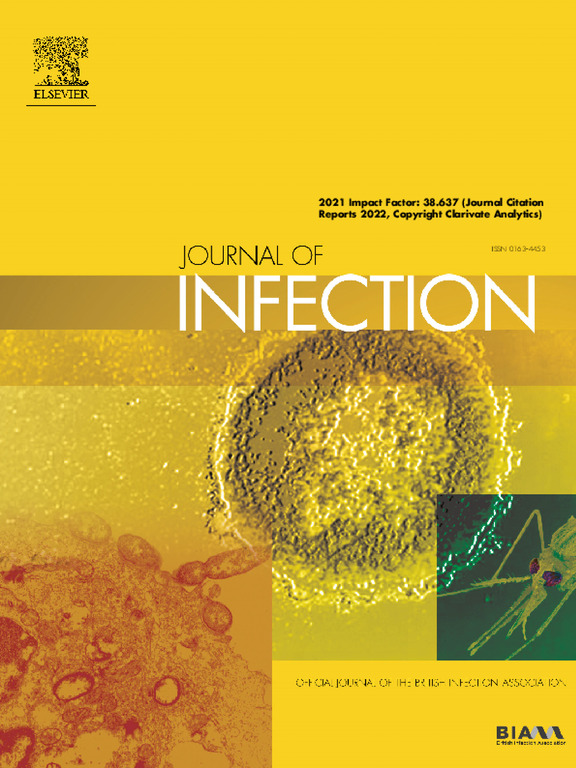Global practice variation of suppressive antimicrobial treatment for prosthetic joint infections: A cross-sectional survey study
IF 11.9
1区 医学
Q1 INFECTIOUS DISEASES
引用次数: 0
Abstract
Objectives
To identify global differences in the use of suppressive antimicrobial therapy (SAT) in the management of prosthetic joint infection (PJI).
Methods
An online survey was designed to investigate clinician’s approach to SAT for PJI, including indications, preferred antimicrobial drugs, dosing, treatment duration and follow-up. The survey was distributed to members of four international (bone and joint) infection societies and study groups.
Results
Respondents comprised 330 physicians (204 infectious diseases specialists, 110 orthopedic surgeons, 23 clinical microbiologists) from 43 different countries (Europe, n = 134, 41%; Oceania n = 112, 34%; North America, n = 51, 16%; other, n = 33, 10%; total response rate 20%). After debridement, antibiotics and implant retention (DAIR) or one-stage revision, SAT would be initiated often or almost always by 38% of respondents from North America, but only in 6% from Europe and 7% from Oceania. First choices of SAT for staphylococcal PJI were oral cephalosporins (39%) and tetracyclines (31%) in North America; tetracyclines (27%) and anti-staphylococcal penicillins (22%) in Europe; and anti-staphylococcal penicillins (55%) in Oceania. There was no global or regional preferred SAT regimen for Gram-negative PJI. Of all respondents, dosage of SAT was never lowered (n = 126, 38%), lowered for specific antibiotics (n = 125, 38%) or lowered for all antibiotics (n = 79, 24%). SAT was prescribed for a lifelong duration (n = 43, 13%), a fixed duration (range 6 months–3 years) (n = 104, 32%) or for an undetermined duration (n = 154, 47%).
Conclusions
Approach to SAT in PJI is highly regional, with no consensus regarding the indication, selection, dose, or duration of SAT between physicians worldwide. This reflects the paucity of data and need for high quality studies to define the optimal use of SAT in the treatment of patients with PJI.
假体关节感染抑制性抗菌治疗的全球实践差异:一项横断面调查研究。
目的确定全球在使用抑制性抗菌疗法(SAT)治疗人工关节感染(PJI)方面的差异:方法: 设计了一项在线调查,以调查临床医生对 PJI 采用抑制性抗菌疗法的方法,包括适应症、首选抗菌药物、剂量、疗程和随访。调查对象为四个国际(骨与关节)感染学会和研究小组的成员:受访者包括来自 43 个不同国家的 330 名医生(204 名传染病专家、110 名骨科外科医生、23 名临床微生物学家)(欧洲 134 人,占 41%;大洋洲 112 人,占 34%;北美 51 人,占 16%;其他 33 人,占 10%;总回复率 20%)。在清创、抗生素和种植体保留(DAIR)或一期翻修后,38% 的北美受访者会经常或几乎总是启动 SAT,但只有 6% 的欧洲受访者和 7% 的大洋洲受访者会这样做。在北美洲,治疗葡萄球菌 PJI 的首选 SAT 是口服头孢菌素(39%)和四环素(31%);在欧洲,首选四环素(27%)和抗葡萄球菌青霉素(22%);在大洋洲,首选抗葡萄球菌青霉素(55%)。全球或各地区都没有针对革兰氏阴性 PJI 的首选 SAT 方案。在所有受访者中,从未降低过 SAT 的剂量(126 人,38%)、降低了特定抗生素的剂量(125 人,38%)或降低了所有抗生素的剂量(79 人,24%)。SAT 的处方持续时间为终身(43 人,占 13%)、固定持续时间(6 个月至 3 年不等)(104 人,占 32%)或未确定持续时间(154 人,占 47%):结论:PJI 中的 SAT 治疗方法具有很强的区域性,世界各地的医生对 SAT 的适应症、选择、剂量或持续时间没有达成共识。这反映了数据的匮乏,需要进行高质量的研究,以确定在治疗 PJI 患者时 SAT 的最佳使用方法。
本文章由计算机程序翻译,如有差异,请以英文原文为准。
求助全文
约1分钟内获得全文
求助全文
来源期刊

Journal of Infection
医学-传染病学
CiteScore
45.90
自引率
3.20%
发文量
475
审稿时长
16 days
期刊介绍:
The Journal of Infection publishes original papers on all aspects of infection - clinical, microbiological and epidemiological. The Journal seeks to bring together knowledge from all specialties involved in infection research and clinical practice, and present the best work in the ever-changing field of infection.
Each issue brings you Editorials that describe current or controversial topics of interest, high quality Reviews to keep you in touch with the latest developments in specific fields of interest, an Epidemiology section reporting studies in the hospital and the general community, and a lively correspondence section.
 求助内容:
求助内容: 应助结果提醒方式:
应助结果提醒方式:


